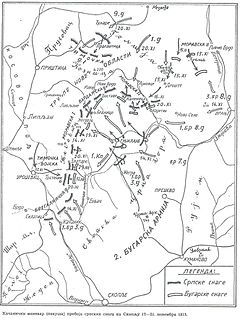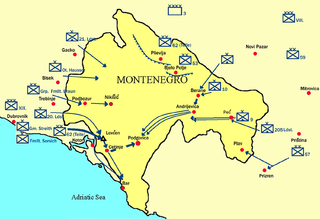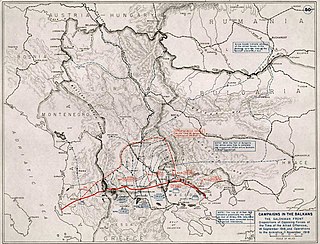
The Balkan Wars consisted of two conflicts that took place in the Balkan Peninsula in 1912 and 1913. Four Balkan states defeated the Ottoman Empire in the first war. In the Second Balkan War, Bulgaria fought against all four original combatants of the first war along with facing a surprise attack from Romania from the north. The conflicts ended catastrophically for the Ottoman Empire, which lost the bulk of its territory in Europe. Austria-Hungary, although not a combatant, became relatively weaker as a much enlarged Serbia pushed for union of the South Slavic peoples. The war set the stage for the Balkan crisis of 1914 and thus served as a "prelude to the First World War".

The League of Balkans was a quadruple alliance formed by a series of bilateral treaties concluded in 1912 between the Eastern Orthodox kingdoms of Greece, Bulgaria, Serbia and Montenegro, and directed against the Ottoman Empire, which at the time still controlled much of Southeastern Europe.

The Eastern Front or Eastern Theater of World War I was a theater of operations that encompassed at its greatest extent the entire frontier between the Russian Empire and Romania on one side and the Austro-Hungarian Empire, Bulgaria, the Ottoman Empire and the German Empire on the other. It stretched from the Baltic Sea in the north to the Black Sea in the south, involved most of Eastern Europe and stretched deep into Central Europe as well. The term contrasts with "Western Front", which was being fought in Belgium and France.
The Serbian First Army was a Serbian field army that fought during World War I.

The Allies of World War I or Entente Powers were the coalition that opposed the Central Powers of Germany, Austria–Hungary, the Ottoman Empire, and Bulgaria during the First World War (1914–1918).

The Serbian campaign of World War I was fought from July 1914, with the three unsuccessful Austria-Hungarian invasions of Serbia, until December 1915, when Serbia was conquered by combined Austria-Hungarian, German and Bulgarian forces under the command of Generalfeldmarschall August von Mackensen. This resulted in the Great Serbian Retreat, the evacuation to Greece and the establishment of the Macedonian front together with the Allies. The defeat of Serbia gave the Central Powers temporary mastery over the Balkans, opening up a land route from Berlin to Istanbul, allowing the Germans to re-supply the Ottoman Empire for the rest of the war. Mackensen declared an end to the campaign on November 24, 1915.

Although considerable conflict took place outside Europe, the European theatre was the main theatre of operations during World War I and was where the war began and ended. During the four years of conflict, battle was joined by armies of unprecedented size equipped with new mechanized technologies, leaving millions dead or wounded.

The Macedonian front, also known as the Salonica front, was a military theatre of World War I formed as a result of an attempt by the Allied Powers to aid Serbia, in the fall of 1915, against the combined attack of Germany, Austria-Hungary and Bulgaria. The expedition came too late and in insufficient force to prevent the fall of Serbia, and was complicated by the internal political crisis in Greece. Eventually, a stable front was established, running from the Albanian Adriatic coast to the Struma River, pitting a multinational Allied force against the Bulgarian Army, which was at various times bolstered with smaller units from the other Central Powers. The Macedonian front remained quite stable, despite local actions, until the great Allied offensive in September 1918, which resulted in the capitulation of Bulgaria and the liberation of Serbia.

The Kosovo Offensive was an offensive launched part of the greater Serbian campaign of World War I, by German, Austro-Hungarian, and Bulgarian units under the command of Prussian Field Marshal Mackensen. It was conducted in the area of Kosovo where the Serbian army had successfully retreated, during the second half of November 1915. The ultimate goal of the offensive was to encircle and destroy the remnants of the Serbian army. The defeat of Serbia and the forced exile of its army and government marked the end of the Serbian Campaign.

The Battle of Dobro Pole, also known as the Breakthrough at Dobro Pole, was a World War I battle fought between 15 and 18 September 1918. The battle was fought in the initial stage of the Vardar Offensive, in the Balkans Theatre. On September 15, a combined force of Serbian, French and Greek troops attacked the Bulgarian-held trenches in Dobro Pole, at the time part of the Kingdom of Serbia. The offensive and the preceding artillery preparation had devastating effects on Bulgarian morale, eventually leading to mass desertions.

The Kingdom of Bulgaria participated in World War I on the side of the Central Powers from 14 October 1915, when the country declared war on Serbia, until 30 September 1918, when the Armistice of Thessalonica came into effect.

This article is about Italian military operations in World War I.

The Vardar Offensive was a World War I military operation, fought between 15 and 29 September 1918. The operation took place during the final stage of the Balkans Campaign. On September 15, a combined force of Serbian, French and Greek troops attacked the Bulgarian-held trenches in Dobro Pole, at the time part of the Kingdom of Serbia. The assault and the preceding artillery preparation had devastating effects on Bulgarian morale, eventually leading to mass desertions.
Albania during World War I was an independent state, having gained independence from the Ottoman Empire, on 28 November 1912, following the First Balkan War. It was recognized by the Great Powers as the Principality of Albania, after Turkey officially renounced all its rights in May 1913. A new country with various ethnic groups, it quickly unraveled and just a few months after taking power, its ruler, Austro-Hungarian aristocrat, Prince William of Wied, was forced to flee. After World War I broke out, anarchy took hold of the country as tribes and regions rebelled against central rule. To protect the Greek minority, Greek control was established in the southern districts replacing the Northern Epirote units beginning in October 1914. In response to this, Italy, although officially neutral, also sent troops into the port of Vlorë, while Serbia and Montenegro took control of northern regions. In 1915 Serbia was overrun by combined German, Austro-Hungarian, and Bulgarian forces; the Serbian army retreated across the mountain passes of northern Albania, towards the Adriatic. Italian troops drove the Greeks from southern Albania and brought almost all Albanian territory under their control. Austrian forces invaded in June 1916, Austro-Hungarian forces remained in Albania until the end of the war when a multinational Allied force broke through and pushed them out in 1918.

The Battle of Krivolak was a World War I battle, fought between 21 October and 22 November 1915. The battle was fought in the initial stage of the Macedonian campaign, in the Balkans Theatre. On October 21, Bulgarian troops attacked the French-held positions near the Strumica rail station, at the time part of the Kingdom of Serbia, starting the battle. Fighting continued until November 22, when two Serbian divisions failed to capture Skopje, thus rendering the continuation of Entente offensive operations dangerous and forcing the French to evacuate their forces from the region.

The Great Retreat, also known as the Albanian Golgotha , took place during the First World War following the invasion of Serbia by the Central Powers. Facing total destruction but refusing to come to terms, the government and the supreme command made the decision, on 23 November 1915, to retreat through Montenegro and Albania where they hoped to reach the Adriatic coast and be rescued by Allied ships.

The Montenegrin Campaign of World War I, in January 1916, was a part of the Serbian Campaign, in which Austria-Hungary defeated and occupied the Kingdom of Montenegro, an ally of Serbia.

The Battle of Kosturino was a World War I battle, fought between 6 and 12 December 1915. The battle was fought in the initial stage of the Macedonian campaign, in the Balkans Theatre. On December 6, a Bulgarian troops attacked the French and British-held trenches in Kosturino, at the time part of the Kingdom of Serbia. The offensive was at first held in check, however on December 8, Bulgaria managed to infiltrate the Memesli ravine. Bulgaria then seized Crete Simonet, thus threatening to outflank the Allies. The Entente defeat at Kosturino led to the complete withdrawal of Allied forces from Serbia, thus enabling the Central Powers to build the Berlin to Constantinople rail line. The Allies in the meantime concentrated on solidifying their defenses in Greece.

The Allied Army of the Orient (AAO) was the name of the unified command over the multi-national allied armed forces on the Salonika Front during the First World War.

The Liberation of Serbia, Albania and Montenegro was a military action in the Balkans in the final weeks of World War I. Between 29 September and 11 November 1918, the Allied Army of the Orient liberated these three countries from occupation by the Central Powers.





















